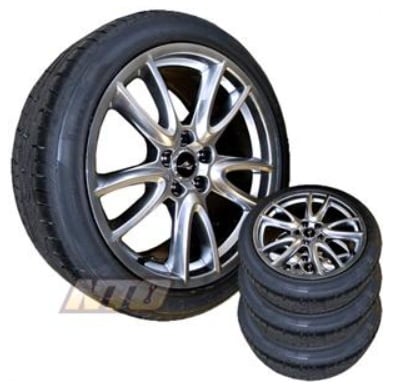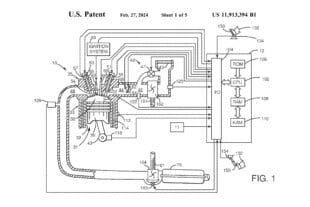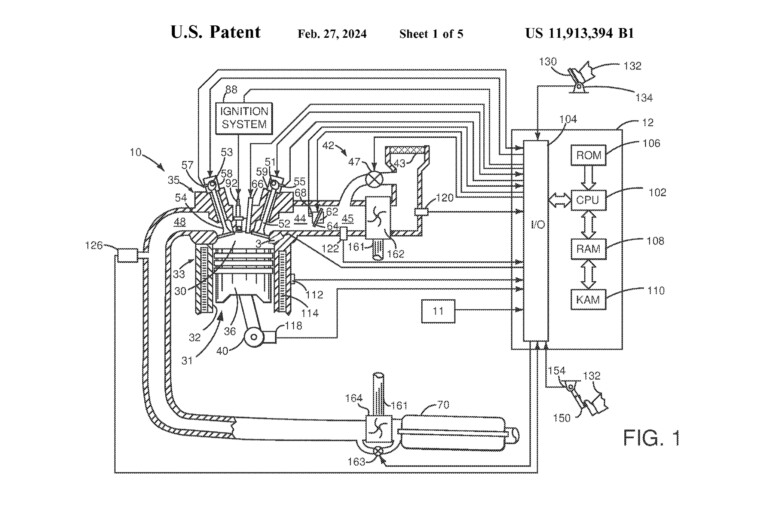While Ford’s Coyote 5.0 is a respectable performer straight from the factory, there’s plenty of room for improvement for those who’re looking to get a bit more out of it. Since the advent of the internal combustion engine, tuners have often found that the exhaust system is a great place to start when looking to gain some additional grunt. This is due not only to the immediate performance benefits that can be had, but also because an improvement in exhaust flow often translates to bigger gains from subsequent modifications done down the road.
Headers are one of the most common bolt-ons performance enthusiasts reach for first. Determining what size primaries, lengths, and collector arrangements will be best for an application can involve a lot of hearsay without data. To clear up the confusion we decided to test a couple of popular choices from Hooker (PN. 70103305-RHKR), and Kooks (PN. 11412400). Working our way through 1-5/8, 1-3/4, to 1-7/8-inch diameter primaries.
With the massive aftermarket support for Coyote, options for aftermarket headers are plentiful. That’s undoubtedly a benefit to enthusiasts, but it also presents a new issue – how to determine the best option for your particular application. There’s a number of factors to consider here, and going into the selection process blindly could prove to be a mistake that can cost you time, money, and horsepower.
With the assistance of dynamometer guru Steve Brulé of Westech Performance, we set to work with our Coyote test mule to get the low-down about how different long-tube header primaries change the engine's power delivery.
Using the 5.0 we built for the LS3 versus Coyote Budget Shootout series as our test bed, we hit the dyno at Westech Performance to see how different primary sizes and header designs can change the Coyote’s powerband, and spoke with the exhaust experts at Hooker and Kooks about how to select the right headers to optimize performance for your build.
The Test Mule
In the interest of keeping the shootout on a level playing field between the Ford and Chevy, we established a number of specifics for the build. Ultimately we wanted to replicate the kind of motor an enthusiast might put together in his or her garage, and to that end, we established a $9,999 budget cap for parts.

Our budget shootout criteria specified that each motor would run near-stock displacement, roughly 11:1 compression, hydraulic roller camshafts and 91 octance gas on a factory PCM. Getting the Coyote build to land in the $9,999 budget cap took some ingenuity. Rather than starting with a new block, we pulled one from a wrecked 2012 F150, as the core components (long block, crankshaft, etc) are identical to those used on the Mustang GT.
This had a fairly significant effect on the potential parts list, particularly for the Coyote. You can get all the details on the Coyote build here, but some of the key items of interest are the forged Manley Performance pistons (PN 598010-C), the street-friendly set of hydraulic camshafts (Comp Cams Stage 3 XFI NSR – PN 191160), and the Aeromotive billet fuel rails (PN 14130).
The combination we selected for the 5.0 resulted in a peak output of 510.4 horsepower at 7,600 rpm and 398.4 lb-ft of torque at 5,400 rpm – a substantial bump up from stock 5.0 in a new Mustang GT but still well within the realm of typical street performance.

The Coyote’s baseline pull, seen here, resulted in a peak output of 510.4 horsepower at 7,600 rpm and 398.4 lb-ft of torque at 5,400 rpm. While the Coyote is making enough power to justify using a set of aftermarket headers rather than the stock manifolds, we wanted to find out if different primary diameters (along with overall design) could unlock additional output.
Aside from budget considerations, our parts selection was largely determined with the goal of building a reliable, durable, and high-revving motor that could serve as a solid foundation for additional upgrades down the road, including forced induction.
This configuration serves as a solid foundation to see how different header designs can change the Coyote’s powerband in terms of where it makes power along the rev range and what gains can be had using headers of different designs.
Matching Design To Application
When an OEM like Ford sits down to design exhaust manifolds for an engine, there’s a whole host of factors that must be considered, many of which have the potential to compromise overall performance. Along with emissions compliance, auto manufacturers must consider things like ease of installation on the assembly line, noise, harshness and vibration levels, production costs, and so on.
Since aftermarket exhaust components cater specifically to enthusiasts many of these factors don’t apply, so the engineers at companies like Kooks and Hooker have the ability to make performance a much higher priority in the design phase.
Given this level of freedom for header design, the aftermarket has a much broader range of options as their disposal, but deciding which one will be best suited to a particular application requires the consideration of several factors, starting with the headers’ general construction.
Four-into-one style headers like these ones from Hooker (PN. 70103305-RHKR) offer the most versatility in terms of tuning, and they're also generally the easiest to deal with when it comes to vehicle packaging. Both of these characteristics play a big role in this design's overwhelming popularity in street car applications.
Four-into-one headers are the most popular header design out there for both street and race applications. This configuration allows for the widest range of variations in length, primary and secondary diameters, and shape, in turn allowing engineers to dial in a particular offering for specific uses. “Along with being relatively simple to design and inexpensive to produce, four-into-one headers are a popular choice for fitment concerns as well,” explains Keith Jesee of Hooker Headers. “They’re typically also the most cost effective option among long-tube headers.”
Tri-Y style headers began to gain popularity after Carroll Shelby chose this design for the original Mustang GT350. This design creates an overall length similar to four-into-one headers using a three-collector combination that pairs up cylinders based on the firing order of the engine, with sequential pairing providing optimum performance. “A Tri-Y header is very beneficial for building mid-range torque and high-rpm horsepower,” Jesee points out. “It helps to further separate the exhaust pulses and maximize the scavenging effect a long-tube header can create.”

Tri-Y headers like this Flowtech set for 1965-70 Ford small blocks show the most advantage in the mid-to-upper rev range. As a result, these are more often found on purpose-built road race cars than street cars. In terms of the latter, gains across the rev range would be more desirable and packaging concerns make using Tri-Y style headers more difficult in engine bays where space is at a premium.
But unlike four-into-one headers, the Tri-Y design is often catered toward improvements in specific areas of the powerband rather than overall gains, and more stringent design requirements are needed in order for Tri-Y headers to yield those benefits.
“The data we have collected over the years proves the Tri-Y design does have advantages in race applications with the right vehicle and the right engine combination on the right track,” explains Chris Clark of Kooks Headers. “You need to have the proper primary size for the engine displacement and application. The collectors also need specific convergent angles (7-20 degrees) for optimum efficiency and cannot be a random bend angle. We have seen horsepower and torque numbers dramatically affected by these angles in Tri-Y headers, and therefore using a Tri-Y on a production street car, where the design of the primaries and merges is limited by the restraints of the car’s design, is typically not optimal. With a Tri-Y there is no ‘one size fits all’ solution to obtain the benefits of this style of header.”
Stepped headers are another design option to consider. Stepped headers merge different diameter tubing at different sections of the header to optimize efficiency. In a stepped header design the smaller diameter close to the exhaust port allows for better exhaust gas velocity, which helps build low-end torque, while the larger diameter tube down towards the collector helps to keep high rpm horsepower up. But it’s worth noting that step headers are typically more costly than their non-step counterparts, as this design adds complexity to the manufacturing process.

Stepped headers like this set from Kooks seek to merge the benefits of small diameter primaries and larger diameters near the collector to improve both horsepower in the upper rev range and torque down low, but it typically comes at an additional cost versus standard long-tube headers.
“Stepped headers can help provided they have a specific application they’re designed to fit,” Clark points out. “In a street car application these typically have little effect, if any. They’re generally designed for high output, naturally aspirated engines used for motorsport, and their potential benefit is usually determined on a case-by-case basis.”
On the other end of the spectrum we have shorty headers. “Shorty headers are a great choice when you’re looking to improve performance but need to retain catalytic converters – or simply save a little money,” Jesee notes. Unlike long-tube headers, shorties can be emissions compliant in some cases – a factor worth considering in states like California, where no long-tube headers are compliant with smog regulations.
Kooks uses 304 stainless steel for all of their Coyote header offerings including these long-tube headers (PN. 11412400), as it provides superior longevity and crack resistance versus mild steel, which is more often used in racing applications where the header isn't expected to last the life of the vehicle.
But not all shorty headers are created equal. In some cases, switching over from the factory piece might actually decrease performance. “It all depends on the specific design,” says Clark. “If the routing is poorly done, it can actually have a negative effect versus the factory exhaust manifold.” But in some cases there can be a tangible benefit to switching over to shorties from the factory piece. “Along with the routing, how much tube length you can design into it will also be a determining factor, and most of the benefit [in terms of the Coyote motor] will be in the upper rev range.”

These shorty headers from Kooks (PN. 164100) have been shown to provide 8-rwhp over the stock manifolds on the 2011-14 Coyote motor. Those gains might sound modest until you discover that some shorty headers actually reduce performance.
Shorty headers are also popular for turbocharged street car applications, where maximizing the expansion of hot gasses and in turn exhaust velocity is important, while reducing the distance exhaust gas needs to travel. These benefits are desirable in order to minimize the time required to spool up the turbo, in turn minimizing the potential for lag. This is less of an issue in motorsport-specific turbocharged applications, where the engine will typically spend the majority of the time in the upper rev range, and therefore already on boost.
Testing Results
“The main factors that influence the size of a header have to do with engine displacement and rpm,” Jesee points out. “Typically, smaller headers such as a 1-5/8-inch primary are going to produce a little better torque at low engine speeds, especially on smaller displacement engines. But these headers can also become a restriction at higher engine speeds. This is more evident on larger displacement engines. Just the opposite is true with larger headers – they tend to sacrifice bottom end torque while allowing for more high-rpm horsepower.”

The 1-5/8-inch primary headers topped out at 527.6 hp @ 7600 rpm and 412.3 lb-ft of torque at 5500 rpm, gains of 17.2 horsepower and 13.9 pound-feet over the baseline run.

The 1-3/4-inch topped out at 531.6 at 7700 rpm and 406.2 at 5400 rpm, gains of 21.2 hp and 7.8 pound-feet over the baseline pull.

The 1-7/8-inch primary long-tubes generated 531.2 horsepower at 7600 rpm and 406.5 lb-ft at 5500, gains of 20.8 hp and 8.1 pound-feet over baseline.
“Another deciding factor that people forget about is packaging,” he adds. “It can be a real challenge to get a big 2 ¼” primary header to fit around power steering components, oil filters, subframes, etc.”
When it comes to typical street-driven builds like our test motor here, the main factor often comes down to engine output. But Clark points out that the 32-valve Coyote motor defies conventional wisdom to some degree.
“We’ve made up to 700 horsepower on a Coyote motor using 1-5/8-inch primary headers. You simply couldn’t do that with a comparable LS motor, you’d need to step up to a 1-3/4-inch at minimum. Much of it comes down to the sheer efficiency of the modular Ford – in terms of designing headers for it, it’s an ideal package.”























